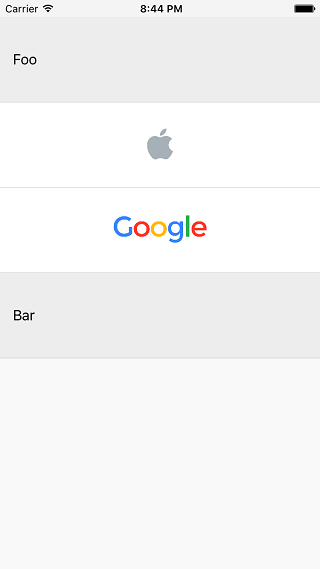对(几乎)所有的 iOS 开发者来说,UITableView 就像是面包和黄油一样必不可少。大部分情况下,我们用一个 UITableViewCell 展现一种数据类型,然后通过 Identifier 来重用单元格。在 objc.io 中介绍了这种技术。当我们想在一个 Table View 中使用多个不同类型的 cell 时,情况则复杂的多。cell 的不一致让我们很难处理。
本文介绍了解决这个问题的三种途径。每种方案都试图修复前一种方案中导致的问题。***种方法在许多 O-C 代码库中都很常见。第二种方法利用了枚举,但仍然不是***的解决办法。第三种方法的实现使用了协议和泛型——它们是 Swift 提供给我们的神兵利器。
基础
我会带你完成一个 demo 项目(github 地址),在这个例子中,我们创建了一个包含两种不同 cell 的 Table View:一种 cell 用于显示文本,一种 cell 用于显示图片,如下图所示:
显示两种数据(文字和图片)的 UITableView
在渲染视图时,我喜欢用值类型来封装数据。我把这个称作 view data。这里,我们使用了两个 view data:
- struct TextCellViewData {
- let title: String
- }
- struct ImageCellViewData {
- let image: UIImage
- }
(在真实项目中可能会有更多属性;image 属性应该声明为 NSURL ,以免对 UIKit 产生依赖)。对应地,我们也需要两种 cell 来展现这两种 view data:
- class TextTableViewCell: UITableViewCell {
- func updateWithViewData(viewData: TextCellViewData) {
- textLabel?.text = viewData.title
- }
- }
- class ImageTableViewCell: UITableViewCell {
- func updateWithViewData(viewData: ImageCellViewData) {
- imageView?.image = viewData.image
- }
- }
然后,我们开始进入 View Controller 中。
***种方法:简单方法
我不喜欢一开始就讲很复杂的东西,一开始,先讲一个简单的实现,用于显示一点东西在屏幕上。
我们想让 Table View 受数组中的数据驱动(准确地说是 items 数组)。因为我们的数据是完全不同的两种结构体,所以数组的类型只能是 [Any]。在 registerCells() 方法中我们使用标准的 cell 重用机制提前注册了 cell。在 tableView(_:cellForRowAtIndexPath:) 方法中我们根据指定 IndexPath 所对应的 view data 的类型来创建 cell。我们的 View Controller 的完整实现非常简单(为简便起见,我们用 ViewController 作为 Table View 的数据源。在真实项目中,我们可能需要将数据源抽离到一个单独的对象中。):
- class ViewController: UIViewController {
- @IBOutlet weak var tableView: UITableView!
- var items: [Any] = [
- TextCellViewData(title: "Foo"),
- ImageCellViewData(image: UIImage(named: "Apple")!),
- ImageCellViewData(image: UIImage(named: "Google")!),
- TextCellViewData(title: "Bar"),
- ]
- override func viewDidLoad() {
- super.viewDidLoad()
- tableView.dataSource = self
- registerCells()
- }
- func registerCells() {
- tableView.registerClass(TextTableViewCell.self, forCellReuseIdentifier: textCellIdentifier)
- tableView.registerClass(ImageTableViewCell.self, forCellReuseIdentifier: imageCellIdentifier)
- }
- }
- extension ViewController: UITableViewDataSource {
- func tableView(tableView: UITableView, numberOfRowsInSection section: Int) -> Int {
- return items.count
- }
- func tableView(tableView: UITableView, cellForRowAtIndexPath indexPath: NSIndexPath) -> UITableViewCell {
- let viewData = items[indexPath.row]
- if (viewData is TextCellViewData) {
- let cell = tableView.dequeueReusableCellWithIdentifier(textCellIdentifier) as! TextTableViewCell
- cell.updateWithViewData(viewData as! TextCellViewData)
- return cell
- } else if (viewData is ImageCellViewData) {
- let cell = tableView.dequeueReusableCellWithIdentifier(imageCellIdentifier) as! ImageTableViewCell
- cell.updateWithViewData(viewData as! ImageCellViewData)
- return cell
- }
- fatalError()
- }
- }
这个方法是可行的,但至少有以下几个原因让我不太满意:
-
我们无法重用这个 ViewController。如果我们想再加入一种新的 cell,比如用于显示视频,我们不得不在三个地方修改代码:
1. 加入一个新的可重用 Identifier
2. 修改 registerCells() 方法
3. 修改 tableView(\_:cellForRowAtIndexPath:) 方法
-
如果我们修改 items,提供给它一种 view data,而这种 view data 类型是我们无法处理的,则我们会触发 tableView(\_:cellForRowAtIndexPath:) 方法中的 fatalError()。
-
在 view data 和 cell 之间存在关联性,但在类型系统中却无法体现这种关联性。
第二种方法:枚举
我们可以添加一个 TableViewItem 枚举类型来从某种程度上解决这些问题,在枚举中,我们将 view data 所支持的所有类型都列举进去:
- enum TableViewItem {
- case Text(viewData: TextCellViewData)
- case Image(viewData: ImageCellViewData)
- }
然后将 items 属性的类型修改为 [TableViewItem]:
- var items: [TableViewItem] = [
- .Text(viewData: TextCellViewData(title: "Foo")),
- .Image(viewData: ImageCellViewData(image: UIImage(named: "Apple")!)),
- .Image(viewData: ImageCellViewData(image: UIImage(named: "Google")!)),
- .Text(viewData: TextCellViewData(title: "Bar")),
- ]
再修改 registerCells() 方法:
- func registerCells() {
- for item in items {
- let cellClass: AnyClass
- let identifier: String
- switch(item) {
- case .Text(viewData: _):
- cellClass = TextTableViewCell.self
- identifier = textCellIdentifier
- case .Image(viewData: _):
- cellClass = ImageTableViewCell.self
- identifier = imageCellIdentifier
- }
- tableView.registerClass(cellClass, forCellReuseIdentifier: identifier)
- }
- }
***,修改 tableView(_:cellForRowAtIndexPath:) 方法:
- func tableView(tableView: UITableView, cellForRowAtIndexPath indexPath: NSIndexPath) -> UITableViewCell {
- let item = items[indexPath.row]
- switch(item) {
- case let .Text(viewData: viewData):
- let cell = tableView.dequeueReusableCellWithIdentifier(textCellIdentifier) as! TextTableViewCell
- cell.updateWithViewData(viewData)
- return cell
- case let .Image(viewData: viewData):
- let cell = tableView.dequeueReusableCellWithIdentifier(imageCellIdentifier) as! ImageTableViewCell
- cell.updateWithViewData(viewData)
- return cell
- }
- }
不可否认,这种方法比上一种方法更好:
-
View Controller 只能提供枚举中指定的 view data 类型。
-
用 switch 语句代替了烦人的 if 语句,同时可以去掉 fatalError()。
然后我们还可以改进这个实现,比如将单元格的重用和设置修改为:
- func tableView(tableView: UITableView, cellForRowAtIndexPath indexPath: NSIndexPath) -> UITableViewCell {
- let item = items[indexPath.row]
- switch(item) {
- case let .Text(viewData: viewData):
- return tableView.dequeueCellWithViewData(viewData) as TextTableViewCell
- case let .Image(viewData: viewData):
- return tableView.dequeueCellWithViewData(viewData) as ImageTableViewCell
- }
- }
但是悲催的是,我们得在所有的地方都要加入这些 switch 语句。到目前为止,我们只在两个地方使用了 switch 语句,但不难想象绝不仅限于此。例如,当自动布局将变得不可用我们必须使用手动布局时,我们必须在 tableView(\_:heightForRowAtIndexPath:) 中再使用一个 switch 语句。
这个方法不是不可以使用,但我始终对那些 switch 语句耿耿于怀,于是我打算更进一步。
第三种(***)方法:协议和泛型
让我们彻底推翻前两种解决办法,另起炉灶。
声明 Updatable 协议
我们的 cell 是根据 view data 来呈现不同界面的,因此我们定义一个 Updatable 协议,同时让它和一个类型 ViewData 进行绑定:
- protocol Updatable: class {
- typealias ViewData
- func updateWithViewData(viewData: ViewData)
- }
然后让我们的自定义单元格实现该协议:
- extension TextTableViewCell: Updatable {
- typealias ViewData = TextCellViewData
- }
- extension ImageTableViewCell: Updatable {
- typealias ViewData = ImageCellViewData
- }
看过前两种方法之后,我们不难发现,对于 items 中的每个 view data 对象,我们都需要:
1. 找出要使用哪一种 cell 类
2. 找出要使用哪一个重用 Identifier
3. 用 veiw data 渲染 cell
定义 CellConfigurator 结构
因此,我们另外声明一个结构来包装 view data。用结构来提供更多的属性和功能。不妨把这个结构命名为 CellConfigurator:
- struct CellConfigurator<cell where cell: updatable, cell: uitableviewcell> {
- let viewData: Cell.ViewData
- let reuseIdentifier: String = NSStringFromClass(Cell)
- let cellClass: AnyClass = Cell.self
- ...</cell where cell: updatable, cell: uitableviewcell>
这个是一个泛型结构,使用类型参数 Cell。Cell 有两个约束:首先必须实现了 Updatable 协议,其次它必须是 UITableViewCell 子类。
CellConfigurator 有三个属性: viewData, reuseIdentifier 和 cellClass。viewData 的类型取决于 Cell 的类型,它没有默认值。其他两个属性的值则取决于 Cell 的具体类型(这是 Swift 中的新特性,它真的很棒!)。
- ...
- // further part of CellConfigurator
- func updateCell(cell: UITableViewCell) {
- if let cell = cell as? Cell {
- cell.updateWithViewData(viewData)
- }
- }
***,我们将 UITableViewCell 实例传给 updateCell() 方法,就可以将 viewData 渲染到 cell 上。这里,我们不需要用到 Cell 的类型,因为 UITableViewCell 对象是通过 dequeueReusableCellWithIdentifier(_:forIndexPath:) 方法返回的。呼,这么短的实现,解释起来这么费劲。
然后,在 items 数组中生成 CellConfigurator 实例:
- let items = [
- CellConfigurator<texttableviewcell>(viewData: TextCellViewData(title: "Foo")),
- CellConfigurator<imagetableviewcell>(viewData: ImageCellViewData(image: UIImage(named: "Apple")!)),
- CellConfigurator<imagetableviewcell>(viewData: ImageCellViewData(image: UIImage(named: "Google")!)),
- CellConfigurator<texttableviewcell>(viewData: TextCellViewData(title: "Bar")),
- ]</texttableviewcell></imagetableviewcell></imagetableviewcell></texttableviewcell>
等等,怎么回事?居然出现一个编译时错误?
Type of expression is ambiguous without more context
那是因为 CellConfigurator 是泛型,但 Swift 数组只能保存相同类型,我们不能简单地把 CellConfigurator 和 CellConfigurator 放到同一个数组中。这是对的,但却不是我们想要的。
啊哈,稍等一会,马上搞定。Cell 类型参数实际上只在声明 viewData 的时候用到。因此,我们在 CellConfigurator 中可以不需要指明 Cell 的真实类型。新声明一个非泛型协议:
- protocol CellConfiguratorType {
- var reuseIdentifier: String { get }
- var cellClass: AnyClass { get }
- func updateCell(cell: UITableViewCell)
- }
修改 CellConfigurator,让它实现 CellConfiguratorType:
- extension CellConfigurator: CellConfiguratorType {
- }
现在可以将 items 的类型声明为:
- let items: [CellConfiguratorType]
编译通过。
View Controller
我们现在开始修改 View Controller。 registerCells() 可以变得更简单:
- func registerCells() {
- for cellConfigurator in items {
- tableView.registerClass(cellConfigurator.cellClass, forCellReuseIdentifier: cellConfigurator.reuseIdentifier)
- }
- }
tableView(_:cellForRowAtIndexPath:) 方法也变得更简单了,这真是一个好消息:
- func tableView(tableView: UITableView, cellForRowAtIndexPath indexPath: NSIndexPath) -> UITableViewCell {
- let cellConfigurator = items[indexPath.row]
- let cell = tableView.dequeueReusableCellWithIdentifier(cellConfigurator.reuseIdentifier, forIndexPath: indexPath)
- cellConfigurator.updateCell(cell)
- return cell
- }
为能重用 View Controller,我们还必须再做一些工作。比如让 items 能够从类外部修改。这里就不再多说了,你可以在 GitHub 上参考最终实现的这个框架和 demo:ConfigurableTableViewController
结束语
我们来看一下,***一个方案和前两种方案相比有什么不同:
1. 当我们想增加一种新的 cell 时,不需要修改 View Controller
2. View Controller 是类型安全的。如果我们增加一种 cell 根本不支持的 view data 时,我们会得到一个编译错误。
3. 刷新 cell 时不需要 switch 语句。
看来第三种方法解决了我们所有的问题。我想我们又前进了一步。一种更好的解决办法往往是“众里寻它千百度,蓦然回首,那人却在灯火阑删处”。
感谢 Maciej Konieczny 和 Kamil Ko?odziejczyk 为本文审稿。





























